
Home - Search - Browse - Alphabetic Index: 0- 1- 2- 3- 4- 5- 6- 7- 8- 9
A- B- C- D- E- F- G- H- I- J- K- L- M- N- O- P- Q- R- S- T- U- V- W- X- Y- Z
Lox/Kerosene
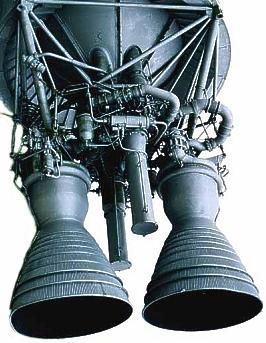
LR-87-3 Engine
Credit: Bob Fortune |
Lox/Kerosene propellant. Liquid oxygen was the earliest, cheapest, safest, and eventually the preferred oxidizer for large space launchers. Its main drawback is that it is moderately cryogenic, and therefore not suitable for military uses where storage of the fuelled missile and quick launch are required. In January 1953 Rocketdyne commenced the REAP program to develop a number of improvements to the engines being developed for the Navaho and Atlas missiles. Among these was development of a special grade of kerosene suitable for rocket engines. Prior to that any number of rocket propellants derived from petroleum had been used. Goddard had begun with gasoline, and there were experimental engines powered by kerosene, diesel oil, paint thinner, or jet fuel kerosene JP-4 or JP-5. The wide variance in physical properties among fuels of the same class led to the identification of narrow-range petroleum fractions, embodied in 1954 in the standard US kerosene rocket fuel RP-1, covered by Military Specification MIL-R-25576. In Russia, similar specifications were developed for kerosene under the specifications T-1 and RG-1. The Russians also developed a compound of unknown formulation in the 1980's known as 'Sintin', or synthetic kerosene.
Specific impulse: 353 s. Specific impulse sea level: 300 s. Location: 1805.
Optimum Oxidizer to Fuel Ratio: 2.56. Temperature of Combustion: 3,670 deg K. Ratio of Specific Heats: 1.24. Density: 1.02 g/cc. Characteristic velocity c: 1,805 m/s (5,921 ft/sec). Isp Shifting: 301 sec. Isp Frozen: 286 sec. Mol: 23.30 M. Oxidizer Density: 1.140 g/cc. Oxidizer Freezing Point: -219 deg C. Oxidizer Boiling Point: -183 deg C. Fuel Density: 0.806 g/cc. Fuel Freezing Point: -73 deg C. Fuel Boiling Point: 147 deg C.
Subtopics
| 11D51F Kuznetsov LOx/Kerosene rocket engine. N1F 1965 - A. Study 1965. As described in N1 improvement study, 1965. Block A engine thrust increased. |
| 11D51M Kuznetsov LOx/Kerosene rocket engine. N1M 1965 - A. Study 1965. As described in N1 improvement study, 1965. Huge modification of Block A engines - sea level thrust increased from 175 metric tons thrust to 250 metric tons. |
| 11D52F Kuznetsov LOx/Kerosene rocket engine. N1F 1965 - B. Study 1965. As per N1 improvement study, 1965. Engine thrust increased from 150 t each to 200 t. |
| 11D52M Kuznetsov LOx/Kerosene rocket engine. N1M 1965 - B. Study 1965. As per N1 improvement study, 1965. Thrust increased to 280 metric tons per engine. |
| 11D53F Kuznetsov LOx/Kerosene rocket engine. N1F 1965 - V. Study 1965. As per N1 improvement study, 1965. Engine thrust increased and stretched propellant tanks resulting in 20% longer burn time. |
| 11D53M Kuznetsov LOx/Kerosene rocket engine. N1M 1965 - V. Study 1965. As per N1 improvement study, 1965. Further increase in thrust of Block V engines. Used on N-IM 1965 launch vehicle. |
 | 17D11 Kosberg Lox/Kerosene rocket engine. Buran OMS and verniers. Out of Production. Buran orbital propulsion system, including 2 x 17D12, 38 x 17D15, 8 x RDMT-200K |
| 17D12 Kosberg Lox/Kerosene rocket engine. Out of Production. Version of RD-58 for Buran orbital propulsion system 17D11. Used synthetic kerosene ('Sintin') for higher specific impulse. |
| 5 mlbf RP-4 Notional LOx/Kerosene rocket engine. Study 1963. Operational date would have been July 1977. Recoverable stage. 10% plug nozzle. Used on Nova-1 DAC launch vehicle. |
| 8D415K Kosberg LOx/Kerosene rocket engine. Designed for use in N-1. Development canceled in 1960 when Korolev turned to Kuznetsov for R-9 and N-1 engines after continuous rows with Glushko over performance and propellant types. First flight was planned for 1966. |
| 8D726 Korolev LOx/Kerosene rocket engine. GR-1 Stage 3, N-11GR - V. Development based on S1.5400. |
| 8K513 Blok B LOx/Kerosene propellant rocket stage. Masses estimated based on total vehicle mass of 117 metric tons. Developed into Molniya/Soyuz second stage. |
 | AABS Rocketdyne LOx/Kerosene rocket engine. Aerospike Annular Booster and Sustainer. Pressure-fed. Booster thrust 3000 to 4000 lb vac; sustainer 1500-2000 lb vac, 257 sec specific impulse. |
| Ames Mach 10 Demonstrator American manned spaceplane. Ames proposed in 1957 to air-launch a high-wing designed hypersonic glider from a B-36 bomber. Early versions would use an XLR-99-powered booster stage and be capable of reaching Mach 6. |
| Angara A-2 LOx/Kerosene propellant rocket stage. Two thrust levels. Propellant ration 2.6:1, chamber pressure 162 bar. |
 | Angara Stage 1 LOx/Kerosene propellant rocket stage. Unique configuration with oxidizer in core and fuel in two tanks strapped on in parallel - all of rail-transportable 3.9 m diameter. Product of Khrunichev. Masses estimated based on engine selected and vehicle performance. |
| Angara UM LOx/Kerosene propellant rocket stage. Can be throttled to 95%. Propellant ration 2.6:1, chamber pressure 257 bar. |
| Atlas CCB LOx/Kerosene propellant rocket stage. Common Core Booster uses Glushko RD-180 engine and new isogrid tanks. Used in Atlas IV/USAF EELV, Atlas V. Includes 272 kg booster interstage adapter and 1297 kg Centaur interstage adapter. |
| Atlas E/F LOx/Kerosene propellant rocket stage. . |
 | Atlas IIIA LOx/Kerosene propellant rocket stage. The American Atlas booster and sustainer engine arrangement was replaced by derivatives of Glushko engines developed for the Ukrainian Zenit launch vehicle. Not capable of single stage to single stage to orbit capability (an Internet spaceflight urban myth). |
| Atlas MA-2 LOx/Kerosene propellant rocket stage. . |
| Atlas MA-3 LOx/Kerosene propellant rocket stage. . |
| Atlas MA-5 LOx/Kerosene propellant rocket stage. . |
 | B-2C Rocketdyne LOx/Kerosene rocket engine. Atlas Booster. Gas generator, pump-fed. Thrust and specific impulse values are at sea level. First flight 1958. |
| Black Colt AV LOx/Kerosene propellant rocket stage. Winged, first stage of a launch vehicle using aerial refueling and existing engines. Takes off from runway; rendezvous with tanker to load oxidizer; then flies to Mach 12/150 nm to release Star 48V second stage and 450 kg payload. 2 x F125 turbofans for flight to tanker, subsonic ferry, and go-around capability on return. |
 | Block D LOx/Kerosene propellant rocket stage. Adaptation of Block D for Energia payload low earth orbital insertion. Used when Buran orbiter not carried. |
| Blok SO-L LOx/Kerosene rocket stage. 66.70 kN (14,995 lbf) thrust. Mass 6,200 kg (13,669 lb). |
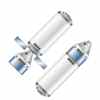 | CEV Spacehab American manned spacecraft. Study 2005. The final Spacehab CEV concept was a three-module spacecraft using a slightly enlarged Apollo command module for return of the crew to earth. |
| CEV Spacehab SM American manned spacecraft module. Study 2005. The Support Module (SM) could provide 2.3 km/s delta-V, enough for lunar orbit insertion and trans-earth injection. It also was the primary source for electrical power during the mission. |
| CZ-NGLV-200 stage LOx/Kerosene propellant rocket stage. From top to bottom the 2.25-m Chinese new generation launch vehicle consists of a 42.3 cubic meter liquid oxygen tank, an intertank section, a 22.0 cubic meter kerosene tank, and an engine section with one gimbaled LOX /Kerosene engines of 1200 kN vacuum thrust. The oxygen tank is pressurized using oxygen bled from the engine and helium is used to pressurize the kerosene tank. The engines can be throttled to 65% of rated thrust. Burn time shown assumes full thrust during engine burn. |
| CZ-NGLV-300 LOx/Kerosene propellant rocket stage. From top to bottom the 3.35-m Chinese new generation launch vehicle consists of a 90.7 cubic meter liquid oxygen tank, an intertank section, a 47.7 cubic meter kerosene tank, and an engine section with two gimbaled LOX /Kerosene engines of 1200 kN vacuum thrust each. The oxygen tank is pressurized using oxygen bled from the engine and helium is used to pressurize the kerosene tank. The engines can be throttled to 65% of rated thrust. Burn time shown assumes full thrust during engine burn. |
| CZ-NGLV-KO LOx/Kerosene propellant rocket stage. Upper stage for the 3.35 m diameter core vehicle. Only information available are the types of propellants, total thrust, and number of engines. Therefore all values shown here except thrust are estimated. This launcher has a low priority since its payload capability overlaps existing Chinese launch vehicles, and it would not be developed until after 2010. |
| D-2 engine Polyarniy LOx/Kerosene rocket engine. R-3. Out of Production. Competing engine for 3000 km range IRBM design to study problems of long-range rockets. Developed from April 1947 until cancellation. |
| Delta 3 - 1 LOx/Kerosene propellant rocket stage. The first stage of the Delta III is powered by a Rocketdyne RS-27A main engine which has a 12:1 expansion ratio and employs a turbine/turbopump, a regeneratively cooled thrust chamber and nozzle, and a hydraulically gimbaled thrust chamber and nozzle that provides pitch and yaw control. |
 | E-1 Rocketdyne LOx/Kerosene rocket engine. Study 1957. Developed by USAF in late 1950's. Cancelled and decision to go direct to 1,500,000 lbf F-1 as next step. Booster applications. Gas generator, pump-fed. |
| EKR Stage 1 LOx/Kerosene propellant rocket stage. First stage for Eksperimentalnaya krilataya raketa (experimental winged rocket), Mach 3 ramjet. Boosted second stage to ramjet ignition conditions. |
| Energia Strapon LOx/Kerosene propellant rocket stage. Essentially identical to Zenit stage 1. |
| Europa-1 LOx/Kerosene propellant rocket stage. . |
 | F-1 Rocketdyne LOx/Kerosene rocket engine. Largest liquid rocket engine ever developed and flown. Severe combustion stability problems were solved during development and it never failed in flight. First flight 1967. |
 | F-1A Rocketdyne LOx/Kerosene rocket engine design of 1968. Improved version of the F-1, which would have been used in any follow-on production of Saturn launch vehicles. Designed for booster applications. Gas generator, pump-fed. |
| Falcon 1-1 LOx/Kerosene propellant rocket stage. . |
| Falcon 1-2 LOx/Kerosene rocket stage. 33.00 kN (7,419 lbf) thrust. |
 | Fastrac Huntsville LOx/Kerosene rocket engine. Development ended 1996. Used on X-34A launch vehicle. Intended to demonstrate lower cost in a reusable simple turbopump rocket engine. |
| FastTrack Notional LOx/Kerosene rocket engine. Design concept. NASA Marshall Space Flight Center prototype experimental engine that led to Fastrac low-cost engine for X-34. |
| GR-1 Stage 1 LOx/Kerosene propellant rocket stage. Payload 4,000 kg (2.2 MT nuclear warhead). Range 13,000 km or orbital. Accuracy (90%) 5 km in range and 3 km in dispersion. Masses estimated based on total vehicle mass of 117 metric tons. |
| GR-1 Stage 3 LOx/Kerosene propellant rocket stage. Masses estimated based on total vehicle mass of 117 metric tons. This stage was a close cousin of that developed for the Molniya launch vehicle. |
 | H-1 engine Rocketdyne LOx/Kerosene rocket engine. Saturn l/lB. Designed for booster applications. Gas generator, pump-fed. First flight 1961. Surplus Saturn motors adapted for use in Delta launch vehicle. |
| H-1-1 LOx/Kerosene propellant rocket stage. License built MB-3 ELT Thor. |
| H-1b Rocketdyne LOx/Kerosene rocket engine. First flight 1966. |
| H-1c Rocketdyne LOx/Kerosene rocket engine. Study Saturn IB-A, Saturn IB-B, 1965. |
| Jarvis-1 LOx/Kerosene propellant rocket stage. . |
| Jupiter Cluster LOx/Kerosene propellant rocket stage. Masses estimated (cluster of four Jupiter IRBM stages). |
| Keldysh Bomber stage LOx/Kerosene propellant rocket stage. Boosted to launch speed of 500 m/s by rocket sled. Boost phase assisted with two ramjets which increases effective specific impulse to over 500 seconds. |
| Keldysh Sled LOx/Kerosene propellant rocket stage. Boosts Keldysh bomber to launch speed of 500 m/s. Mass estimated based on fuel consumed in 11 second boost phase. |
| Kestrel SpaceX LOx/Kerosene rocket engine. Upper stages. Hardware. Pintle architecture, designed to be a high efficiency, low pressure vacuum engine. Fed only by tank pressure, ablative cooled First flight 2006. |
| Kistler Stage 1 LOx/Kerosene propellant rocket stage. Stage burns for 35 seconds to place itself on return-to-launch-site trajectory for recovery. Therefore to calculate performance 12,400 kg propellants for flight back to launch site should be added to empty mass. Empty mass also includes six parachutes, landing bags, and is calculated, based by apportioning total vehicle empty mass. |
| Kistler Stage 2 LOx/Kerosene propellant rocket stage. Empty mass includes payload bay, heat shield, parachutes, and landing bag for recovery at base. Empty mass calculated based by apportioning total vehicle empty mass. |
| KS-50 Glushko LOx/Kerosene rocket engine. Experimental. Development 1948. Subscale versions of a radical new engine design. This featured a flat-plate injector, cylindrical combustion chamber, and a 60 atmosphere chamber pressure. |
| KSR-3 Korean LOx/Kerosene rocket stage using a pressure-fed engine of indigenous design. First flight 2002. |
| Kvant-1 stage Kvant first stage. LOx/Kerosene propellant rocket stage. 4 11D121 verniers. Empty mass estimated. |
| Kvant-1-1 LOx/Kerosene propellant rocket stage. 4 RD-0124-14D23 verniers. Empty mass estimated. |
 | L-1 Linear Aerospike Booster Rocketdyne LOx/Kerosene rocket engine. Gas generator, pump-fed. Thrust and specific impulse values are at sea level. |
 | L-2 Linear Aerospike Booster Rocketdyne LOx/Kerosene rocket engine. Gas generator, pump-fed. Thrust and specific impulse values are at sea level. |
| L-6.55 Notional LOx/Kerosene rocket engine. Study 1963. Engines used in recoverable stage of ballistic shape; separation at 3,420 m/s at 93,900 m altitude; splashdown using retrorockets under 7 parachutes 1340 km downrange. |
| L-7.70 Notional LOx/Kerosene rocket engine. Study 1963. Engines used in recoverable stage; separation at 3,365 m/s at 89,300 m altitude; splashdown using retrorockets under 8 46 m diameter parachutes 1300 km downrange. |
| Liberty 1 LOx/Kerosene propellant rocket stage. . |
| Liberty engine Liberty LOx/Kerosene rocket engine. Development 1994-2006. Pressure-fed engine. Price $ 12,000 in 1995. Used on Scorpius launch vehicle. |
| Liberty-1 Notional LOx/Kerosene rocket engine. Development ended 1988. Pressure-fed engine. Used on Liberty launch vehicle. |
| LR101-11 Rocketdyne LOx/Kerosene rocket engine. In Production. Verniers for RS-27 powerplant, used on Delta boosters 1974-1992. |
| LR105-3 Rocketdyne LOx/Kerosene rocket engine. Out of Production. Early version of Atlas Sustainer. Gas generator, pump-fed. |
 | LR105-5 Rocketdyne LOx/Kerosene rocket engine. Atlas E, F. Atlas Sustainer. Gas generator, pump-fed. Separate turbopumps for each booster engine. First flight 1960. |
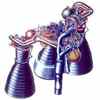 | LR105-7 Rocketdyne LOx/Kerosene rocket engine. Atlas space launchers. Out of production. Atlas Sustainer. Gas generator, pump-fed. Evolved from MA-2 ICBM system. First flight 1963. |
 | LR79-7 Rocketdyne LOx/Kerosene rocket engine. Out of production. Designed for booster applications. Gas generator, pump-fed. First flight 1957. |
 | LR83-NA-1 Rocketdyne LOx/Kerosene rocket engine. Development ended 1958. Planned production version of the engine for the booster of the Navaho G-38 intercontinental cruise missile. |
 | LR87-3 Aerojet LOx/Kerosene rocket engine. Titan 1 booster engine. Surplus Flight Engines were available for various uses in the 1960's. First flight 1959. |
 | LR89-5 Rocketdyne LOx/Kerosene rocket engine. Atlas E, F. Designed for booster applications. Gas generator, pump-fed. Separate turbopumps for each booster engine. First flight 1960. |
 | LR89-7 Rocketdyne LOx/Kerosene rocket engine. Atlas space launchers. Out of production. Designed for booster applications. Gas generator, pump-fed. Shared turbopumps for booster engines. Evolved from MA-2 ICBM system. First flight 1963. |
| LR91-3 Aerojet LOx/Kerosene rocket engine. Development begun 1957. Titan 1 Stage 2 major production version. Proposed for second stage of Juno V-A, Super-Jupiter in 1959. Flown 1959-1965. |
 | MA-5A Rocketdyne LOx/Kerosene rocket engine. Out of Production. Atlas Engine System, an updated version of the MA-5, included replacements with selected RS-27 components for sea-level Isp increase of 4 seconds. First flight 1991. |
 | Mavr Russian manned Mars flyby. Study 1963. A variation of the TMK-1 scenario by Maksimov's unit would still use a single N1 launch. However a flyby of Venus would be undertaken on the return voyage from Mars. |
| MB-3 Press Mod Rocketdyne LOx/Kerosene rocket engine. Test 1962. Used on Sea Horse launch vehicle. |
 | MB-3-1 Rocketdyne LOx/Kerosene rocket engine. Out of production. Designed for booster applications. Gas generator, pump-fed. Boosted Delta A, B, C, Thor Able-Star. First flight 1960. |
 | MB-3-3 Rocketdyne LOx/Kerosene rocket engine. Out of Production. License built in Japan for H-1. First flight 1964. |
 | MB-3-J Rocketdyne LOx/Kerosene rocket engine. N Booster . Gas generator, pump-fed. Joint MHI (Japan) / Rocketdyne project, evolved from MB-3. Thrust and specific impulse values are at sea level. First flight 1975. |
| Merlin 1A SpaceX LOx/Kerosene rocket engine. First stages. Hardware. Completed development in early 2005. Pintle injector concept. Replaced by Merlin 1C. First flight 2006. |
| Merlin 1C SpaceX LOx/Kerosene rocket engine. First stages. Hardware. Regeneratively cooled; turbo-pump also provided high pressure kerosene for the hydraulic actuators. Actuated turbine exhaust nozzle provided roll control. First flight 2008. |
| Merlin 1Cvac SpaceX LOx/Kerosene rocket engine. Hardware. Upper stage version of the Merlin developed for the Falcon 9 second stage. Based on the Merlin 1C and using a regeneratively cooled combustion chamber. First flight 2009. |
 | Michelle-B American manned spacecraft. Study 2004. X-Prize suborbital ballistic spacecraft concept of TGV Rockets, Bethesda, Maryland. As of 2005, flight testing of the Michelle-B was expected to begin no earlier than 2007. |
| Microcosm 22N Microcosm LOx/Kerosene rocket engine. First stages. Hardware. Pressure-fed, ablatively cooled engine using liquid oxygen and jet fuel as propellants. Flown 1999/2001. |
| Microcosm 356N Microcosm LOx/Kerosene rocket engine. First stages. Hardware. Funded under AFRL SBIR Phase 1 contract of 2006. Ablative chamber, LOX/Jet A propellant engines designed for very low-cost, robust design margins. |
| Microcosm 89N Microcosm LOx/Kerosene rocket engine. First stages. Hardware. In 2005 tests were conducted of this low-cost ablative composite rocket engine for responsive launch vehicle applications. |
 | Molniya 8K78-3 LOx/Kerosene propellant rocket stage. Stage designed as fourth stage to take R-7 launched payloads into deep space. Adapted from the Luna / Vostok third stage, but with restart capability. The 700 kg BOZ ullage motors and stabilization platform jettisoned prior to main stage burn. Original version. |
| Molniya 8K78M-3 LOx/Kerosene propellant rocket stage. Standardized improved version for Molniya-type communications satellite payloads. |
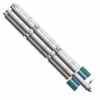 | MPK Russian manned Mars expedition. Study 1956. This first serious examination in the Soviet Union of manned flight to Mars was made by M Tikhonravov. |
 | N1 1962 - A LOx/Kerosene propellant rocket stage. Earlier design for the Block A. Includes 14,000 kg for Stage 1-2 interstage and payload fairing. Compared to total fuelled mass excludes 15,000 kg propellant expended in thrust build-up and boil-off prior to liftoff. Values as in draft project as defended on 2-16 July 1962. |
| N1 1962 - B LOx/Kerosene propellant rocket stage. Includes 3500 kg Stage 2-Stage 3 interstage. Compared to total fuelled mass excludes 1,000 kg in propellants lost to boil-off prior to stage ignition. Values as in draft project as defended on 2-16 July 1962. |
| N1 1962 - V LOx/Kerosene propellant rocket stage. Compared to total fuelled mass excludes 1,000 kg in propellants lost to boil-off prior to stage ignition. Values as in draft project as defended on 2-16 July 1962. |
 | N1 1964 - A LOx/Kerosene propellant rocket stage. First stage of the N1 superbooster. As per draft project for N1-L3, 1964. Block A modified with six additional engines and propellant increased by 550 metric tons by using chilled propellants. |
| N1 1964 - B LOx/Kerosene propellant rocket stage. Second stage of the N1 superbooster. As per draft project for N1-L3, 1964. Specific impulse estimate down one second from 1962 draft project. Thrust said to be increased 2% but not reflected in figures given. |
| N1 1964 - V LOx/Kerosene propellant rocket stage. As per draft project for N1-L3, 1964. Thrust said to be increased 2% but not reflected in figures given. |
 | N1 Block A LOx/Kerosene propellant rocket stage. Includes 14,000 kg for Stage 1-2 interstage and payload fairing. Compared to total fuelled mass excludes 15,000 kg propellant expended in thrust build-up and boil-off prior to liftoff. Values as in draft project as defended on 2-16 July 1962. |
| N1 Block B LOx/Kerosene propellant rocket stage. Includes 3500 kg Stage 2-Stage 3 interstage. Compared to total fuelled mass excludes 1,000 kg in propellants lost to boil-off prior to stage ignition. Values as in draft project as defended on 2-16 July 1962. |
| N1 Block D LOx/Kerosene propellant rocket stage. Block D as originally designed as a lunar crasher stage. |
| N1 Block G LOx/Kerosene propellant rocket stage. Empty mass estimated. |
| N1 Block V LOx/Kerosene propellant rocket stage. As flown. |
| N-11 1963 - V LOx/Kerosene propellant rocket stage. Conjectural stage derived from GR-1 stage 1 to match total mass given of launch vehicle. |
 | N-11 Block A LOx/Kerosene propellant rocket stage. Derived from N1 Block B, with large number of engines and expansion ratio adjusted for sea level operation. Includes 3500 kg Stage 2-Stage 3 interstage. |
| N-11 Block B LOx/Kerosene propellant rocket stage. Derived from N1 Block V. |
| N-111-A LOx/Kerosene propellant rocket stage. Variant of N1 Block V for first stage use. Number of engines would have to be increased and reduced expansion ratio nozzles fitted for sea level use. Least attractive of N1 variants and seems not to have been pursued after draft project. |
| N-111-Ab LOx/Kerosene propellant rocket stage. Alternate weight breakdown. |
| N-11GR - V LOx/Kerosene propellant rocket stage. Orbital MIRV stage. Six of these stages clustered around Block B; each stage would have had a 1500 kg nuclear warhead. |
| N1F 1965 - A LOx/Kerosene propellant rocket stage. As per N1 improvement study, 1965. Block A engine thrust increased but little additional propellant. |
| N1F 1965 - B LOx/Kerosene propellant rocket stage. As per N1 improvement study, 1965. Engine thrust increased from 150 t each to 200 t and stretched propellant tanks. |
| N1F 1965 - V LOx/Kerosene propellant rocket stage. As per N1 improvement study, 1965. Engine thrust increased and stretched propellant tanks with almost 50% increase. |
| N1F Block A LOx/Kerosene propellant rocket stage. Includes 14,000 kg for Stage 1-2 interstage. |
| N1F Block B LOx/Kerosene propellant rocket stage. Includes 3,500 kg for Stage 2-3 interstage. |
| N1M 1965 - A LOx/Kerosene propellant rocket stage. As per N1 improvement study, 1965. Huge modification of Block A, almost double propellant capacity, engines increased from 175 metric tons thrust to 250 metric tons. |
| N1M 1965 - B LOx/Kerosene propellant rocket stage. As per N1 improvement study, 1965. Further stretch of Block B and thrust increased again to 280 metric tons per engine. |
| N1M 1965 - V LOx/Kerosene propellant rocket stage. As per N1 improvement study, 1965. Further stretch of Block V. |
| N1U 1965 - A LOx/Kerosene propellant rocket stage. As per N1 improvement study, 1965. Primarily improved reliability and produceability compared to first model. |
| N1U 1965 - B LOx/Kerosene propellant rocket stage. As per N1 improvement study, 1965. Primarily improved reliability and produceability compared to first model. |
| N1U 1965 - V LOx/Kerosene propellant rocket stage. As per N1 improvement study, 1965. Primarily improved reliability and produceability compared to first model. |
 | Navaho G-38 Booster LOx/Kerosene propellant rocket stage. Burns out at altitude 21,600 m, Mach 3. Empty Mass estimated. |
 | NK-15 Kuznetsov LOx/Kerosene rocket engine. N-1 stage 1 (block A). Development ended 1964. On the basis of NK-9 the NK-15 was developed for the N-1 launcher. 30 were used on the Block A (Stage 1) of the N-1. First flight 1969. |
| NK-15F Kuznetsov LOx/Kerosene rocket engine. Development 1966-1972. Engine had only a very short nozzle, the 24 engines around the periphery were to expand along a common central plug on the first stage of a studied N1 variant. |
| NK-15V Kuznetsov LOx/Kerosene rocket engine. Development ended 1964. Developed from the NK-9. 8 engines, featuring high-expansion nozzles, used on N1 Stage 2. First flight 1969. |
| NK-19 Kuznetsov LOx/Kerosene rocket engine. N-1 stage 4 (Block G). Development ended 1964. Based on NK-9 engine. Originally developed for the modernized second stage of the R-9 (abandoned). Also to have been used on GR-1 / 8K713 Stage 2. First flight 1969. |
| NK-21 Kuznetsov LOx/Kerosene rocket engine. N-1 stage 3 (block V). Out of production. Based on NK-9 engine. Propellants kerosene T-1 / LOX. 4 engines used in N-1 stage 3 (block V). Used on N1 launch vehicle. First flight 1969. |
| NK-31 Kuznetsov LOx/Kerosene rocket engine. Upgraded version of engines for N-1 stage 4, with multiple ignition capability and increased operational lifetime. Mothballed in 1974. Proposed for Black Colt launch vehicle in 1993. |
 | NK-33 Kuznetsov LOx/Kerosene rocket engine. N-1F stage 1 (block A), Kistler stage 1, Taurus II stage 1. Modified version of original engine with multiple ignition capability. Never flown and mothballed in 1975 after the cancellation of the N1. Resurrected for Kistler, then for Taurus. |
| NK-39 Kuznetsov LOx/Kerosene rocket engine. N-1F stage 3 (Block V). Development ended 1971. Modified version of original engine with multiple ignition capability. Never flown and mothballed after the cancellation of the N1. |
| NK-43 Kuznetsov LOx/Kerosene rocket engine. N-1F stage 2 (Block B), Kistler stage 2. Development completed 1975. Modified version of original engine with multiple ignition capability. Never flown and mothballed after the cancellation of the N1. Resurrected for Kistler. |
| NK-9 Kuznetsov LOx/Kerosene rocket engine. R-9, GR-1 stage 1. Reached phase of stand testing in 1965, but then RD-111 selected. Later planned for 1st Stage of GR-1, but that rocket also cancelled. |
| NK-9V Kuznetsov LOx/Kerosene rocket engine. N-1 stage 2 / N-1 stage 3 / R-9 Stage 2. Developed for 2nd stage of the R-9 ICBM (alternative to RD-111 engine by OKB-456). NK-9 with increased expansion ratio. First flight 1965. |
| NK-9V-11D53 Kuznetsov LOx/Kerosene rocket engine. N-1 stage 3 (block V). Out of Production. Modification of NK-9 engine for the N-1 lunar rocket. May be identical to NK-21 (stage 3). |
| NK-9V-11D54 Kuznetsov LOx/Kerosene rocket engine. N-1 stage 4 (block G). Out of Production. Modification of NK-9 engine for the N-1 lunar rocket. May be identical to NK-19 (stage 4). |
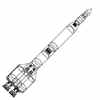 | Nova 2 F-1 Module LOx/Kerosene propellant rocket stage. Short Nova building block. Four used in stage 1, one in stage 2. |
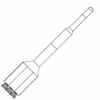 | Nova 59-4-1 LOx/Kerosene propellant rocket stage. Empty Mass Estimated. |
| Nova 59-4-2 LOx/Kerosene propellant rocket stage. Empty Mass Estimated. |
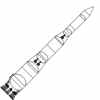 | Nova 60-8-1 LOx/Kerosene propellant rocket stage. Mass estimated based on total LV weight. |
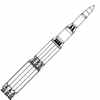 | Nova 9L-1 LOx/Kerosene propellant rocket stage. Masses estimated based on total vehicle thrust, performance, and stage volumes. |
| Nova 9L-2 LOx/Kerosene propellant rocket stage. Masses estimated based on total vehicle thrust, performance, and stage volumes. |
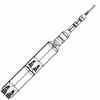 | Nova A-1 LOx/Kerosene propellant rocket stage. . |
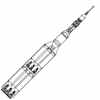 | Nova B-1 LOx/Kerosene propellant rocket stage. . |
| Nova DAC-1 LOx/Kerosene propellant rocket stage. Operational date would have been July 1977. Recoverable stage. 10% plug nozzle. |
| Nova GD-B-1 LOx/Kerosene propellant rocket stage. Massed estimated based on tank volumes, total thrust, and first stage burnout conditions. Recoverable engine package; separation at 3,398 m/s at 76,200 m altitude; splashdown using retrorockets under 7 30 m diameter parachutes 1300 km downrange. |
| Nova GD-F-1 LOx/Kerosene propellant rocket stage. Massed estimated based on tank volumes, total thrust, and first stage burnout conditions. Recoverable stage; separation at 3,365 m/s at 89,300 m altitude; splashdown using retrorockets under 8 46 m diameter parachutes 1300 km downrange. |
| Nova GD-J-1 LOx/Kerosene propellant rocket stage. Massed estimated based on tank volumes, total thrust, and first stage burnout conditions. Recoverable stage of ballistic shape; separation at 3,420 m/s at 93,900 m altitude; splashdown using retrorockets under 7 parachutes 1340 km downrange. |
| Nova MM 1B-1 LOx/Kerosene propellant rocket stage. Operational date would have been December 1972. |
| Nova MM 1C-1 LOx/Kerosene propellant rocket stage. Operational date would have been February 1973. |
 | P4-1 Booster Rocketdyne LOx/Kerosene rocket engine. AQM-37. Target System Booster. Pressure-fed. First flight 1963. |
 | P4-1 Sustainer Rocketdyne LOx/Kerosene rocket engine. AQM-37. Target System Sustainer. Pressure-fed. First flight 1963. |
| PF RP-1 Notional LOx/Kerosene rocket engine. Study 1967. Used on Saturn LCB-LOx/RP-1 launch vehicle. |
 | Pioneer XP American manned spaceplane. Study 2004. X-Prize suborbital spaceplane concept of Pioneer Rocketplane, Solvang, California. No backing forthcoming. |
| Press Fed 25k TRW LOx/Kerosene rocket engine. Design concept 1960's. 1960's designs for 'big dumb booster'. |
 | Project 921-1 LOx/Kerosene propellant rocket stage. Engine chamber pressure 13 to 15 MPa. |
 | Proton 11S824 LOx/Kerosene propellant rocket stage. Originally designed as N1-L3 lunar expedition launch vehicle lunar orbit insertion/lunar crasher stage. Before it could fly on the N1, it was adapted for use with Proton UR-500K as a fourth stage for manned circumlunar flight. It was then further used to launch large Lavochkin bureau unmanned lunar/planetary spacecraft. In the 1970's it was adopted by the Soviet military and standardized for launch of geostationary satellites. |
| Proton 11S824F LOx/Kerosene propellant rocket stage. Also known as Block D-2; article number 11S824F. Without guidance unit (navigation commands come from payload). Successor to 11S824M. Used for launch of Lavochkin Mars-bound spacecraft in 1988 and 1996. |
| Proton 11S824M LOx/Kerosene propellant rocket stage. Also known as Block D-1; article number 11S824M. Without guidance unit (navigation commands come from payload). Successor to 11S824. Used to launch large Lavochkin bureau unmanned lunar/planetary/high earth orbit spacecraft from 1976 to 1989. |
| Proton 11S86 LOx/Kerosene propellant rocket stage. Also known as Block DM; article number 11S86. With guidance unit, designed for insertion of military spacecraft into geosynchronous/ medium earth orbit. Used from 1974 to 1990. Succeeded by 11S861. |
| Proton 11S861 LOx/Kerosene propellant rocket stage. Also known as Block DM-2 (different from commercial Block DM2 (no hyphen!)), article number 11S861. Commercial version designated Block DM1 and is equipped with Saab payload adapter for insertion of AS 4000 bus spacecraft into geosynchronous orbit. With improved guidance system as compared to 11S86, originally designed for insertion of military spacecraft into geosynchronous orbit. Used from 1982 to present. |
| Proton 11S861-01 LOx/Kerosene propellant rocket stage. Also known as Block DM-2M, article number 11S861-01. Commercial versions are Block DM3, with Saab payload dispenser, for insertion of Hughes HS 601 bus spacecraft into geosynchronous orbit; and Block DM4, for insertion of FS-1300 bus spacecraft into geosynchronous orbit. With guidance unit, originally designed for insertion of military spacecraft into geosynchronous orbit. Capable of boosting heavier payloads than 11S861 through use of higher-performance 'Sintin' synthetic kerosene fuel. |
| Proton 17S40 LOx/Kerosene propellant rocket stage. Also known as Block DM-5. Commercial version is Block DM2, with Iridium dispenser, designed for insertion of multiple LM 700 (Iridium) spacecraft into medium earth orbit. With guidance unit, modification of 11S861 stage for heavier payloads and with different payload adapter. |
 | R-3 Korolev 3000 km range intermediate range ballistic missile. Developed April 1947 to 1949 before cancellation. |
| R-7 8K71-0 LOx/Kerosene propellant rocket stage. . |
| R-7 8K71-1 LOx/Kerosene propellant rocket stage. . |
| R-9A Stage 1 LOx/Kerosene propellant rocket stage. Payload 3,500 kg. Range 13,000 km. Accuracy (90%) 8 km in range and 5 km in dispersion with radio guidance; 20 km / 10 km with inertial guidance. Empty mass estimated. |
 | R-9A Stage 2 LOx/Kerosene propellant rocket stage. Empty mass estimated. Developed into Molniya/Soyuz second stage. |
| RD-0102 Kosberg LOx/Kerosene rocket engine. Yak-27V aircraft by Yakovlev. Out of Production. Based on RD-0101. Two ignitions possible. Chamber pressure 41,2 - 16,4 bar. |
| RD-0103 Kosberg LOx/Kerosene rocket engine. T-3, P-1 aircraft by Sukhoi. Out of Production. Based on RD-0102. Chamber pressure 37.3 - 15.7 bar. |
 | RD-0105 Kosberg LOx/Kerosene rocket engine. Luna 8K72, Vostok 8K72 upper stage. Out of production. Developed jointly with OKB-1 in nine months on the basis of OKB-1's steering chamber from the RD-107 engine. First flight 1958. |
 | RD-0106 Kosberg LOx/Kerosene rocket engine. R-9 stage 2. Gas generator cycle. First flight 1961. |
 | RD-0107 Kosberg LOx/Kerosene rocket engine. R-9, Molniya 8K78, Voskhod 11A57 stage 3. Out of Production. Gas generator cycle. |
 | RD-0108 Kosberg LOx/Kerosene rocket engine. Voskhod 11A57, Molniya 8K78 stage 3. First flight 1960. |
 | RD-0109 Kosberg LOx/Kerosene rocket engine. 8A92 Vostok stage 3, 8K72K stage 3 (block E-Vostok). Out of production. Developed in 15 months. First flight 1960. |
 | RD-0110 Kosberg LOx/Kerosene rocket engine. Soyuz 11A511, Molniya-M 8K78M. Precursor RD-0107 used in 11A57 Voskhod stage 2. Modified to increase reliability. First flight 1964. |
 | RD-0124 Kosberg LOx/Kerosene rocket engine. In development. Engine to succeed RD-0110 in second stage of Soyuz. Used staged combustion; chamber pressure increased from 70 to 160 bar, specific impulse from 326 to 359 seconds. First flight 2001. Proposed for small launcher Kvant-1 by RKK Energia for stage 1 steering engine. Also proposed by RKK Energia in initial studies in 1993 for Angara upper stage. |
| RD-0124-14D23 Kosberg LOx/Kerosene rocket engine. Proposed in 1993 for Angara stage 2 verniers, Kvant-1 stage 1 vernier. Designed 1986-1990. Variant of RD-0124 with shortened nozzle for sea-level operation. |
| RD-0124M Kosberg LOx/Kerosene rocket engine. Developed 1998-. Proposed single chamber variant of RD-0124. Obviously same turbopumps, but one single chamber. |
| RD-0124M1 Kosberg LOx/Kerosene rocket engine. Developed 1998-. Proposed single chamber variant of RD-0124. Obviously same turbopumps, but one single chamber with larger nozzle extension compared to RD-0124M. |
 | RD-0154 Kosberg LOx/Kerosene rocket engine. Design concept 2007. Engine proposed to replace RD-110 in Avrora improved version of Soyuz launch vehicle. The single chamber engine had a deployable nozzle extension for improved vacuum specific impulse. |
 | RD-0155 Kosberg LOx/Kerosene rocket engine. Engine proposed to replace RD-107 in Onega and Avrora versions of the Soyuz launch vehicle. |
| RD-0210-HC Kosberg LOx/Kerosene rocket engine. Design concept 1990's. Proposed variant of RD-0210 engine using LOX-kerosene instead of N2O4/UDMH as propellants. |
| RD-0234-HC Kosberg LOx/Kerosene rocket engine. Developed 1996-. Proposed variant of RD-0234 engine using LOX-kerosene instead of N2O4/UDMH as propellants. |
| RD-0242-HC Kosberg LOx/Kerosene rocket engine. Developed 1998-. Proposed variant of RD-0242 engine using LOX-kerosene instead of N2O4/UDMH as propellants. |
| RD-0244-HC Kosberg LOx/Kerosene rocket engine. Design concept 1990's. Proposed variant of RD-0244 engine using LOX-kerosene instead of N2O4/UDMH as propellants. |
| RD-0245-HC Kosberg LOx/Kerosene rocket engine. Design concept 1990's. Proposed variant of RD-0245 engine using LOX-kerosene instead of N2O4/UDMH as propellants. |
| RD-0256-HC Kosberg LOx/Kerosene rocket engine. Design concept 1996-. Proposed variant of RD-0256 engine using LOX-kerosene instead of N2O4/UDMH as propellants. |
| RD-105 Glushko LOx/Kerosene rocket engine. R-7 ICBM stage 1 (strap-on) initial project. Out of Production. Single chamber engine intended for the R-7 strap-ons in mid-1950s. Subsequently replaced by the 4 chamber RD-107. |
| RD-106 Glushko LOx/Kerosene rocket engine. R-7 ICBM stage 2 (core) initial project. Out of Production. Single chamber engine intended for the R-7 sustainer. Version of RD-105 with larger nozzle. Subsequently replaced by the 4 chamber RD-108. |
 | RD-107-11D511 Glushko LOx/Kerosene rocket engine. Soyuz 11A511-0, Soyuz 11A511U-0. Design 2000. Diameter is per chamber. First flight 1965. |
 | RD-107-11D511P Glushko LOx/Kerosene rocket engine. Soyuz 11A511U2-0. Out of production. OKB Glushko. Used on 11A511U2 Stage 0. Propellants kerosene (RG-1) / LOx. Diameter is per chamber. First flight 1982. |
 | RD-107-8D728 Glushko LOx/Kerosene rocket engine. Molniya 0, Molniya 8K78M-0. OKB Glushko. Used on Molniya 8K78M and 11A57 Stage 0. Propellants kerosene (RG-1 or T-1) / LOx. Diameter is per chamber. First flight 1964. |
 | RD-107-8D74 Glushko LOx/Kerosene rocket engine. R-7 8K71, Vostok 8K72, Vostok 8K72K strap-ons. First flight 1957. Used four combustion chambers fed by single turbopump to circumvent combustion instability problems with larger chambers 1950's. |
 | RD-107-8D74-1958 Glushko LOx/Kerosene rocket engine. Luna 8K72-0. Out of production. Diameter is per chamber. First flight 1958. |
| RD-107-8D74-1959 Glushko LOx/Kerosene rocket engine. Out of production. Diameter is per chamber. Used on Vostok 8K72K launch vehicle. First flight 1960. |
 | RD-107-8D74K Glushko LOx/Kerosene rocket engine. Developed in 1957-1960. Used in strap-ons for Molniya 8K78, R-7A 8K74, Voskhod 11A57, Vostok 8A92, Vostok 8A92M. Fuel T-1 or RG-1 kerosene. First flight 1959. |
 | RD-107-8D74PS Glushko LOx/Kerosene rocket engine. Sputnik 8K71PS-0. Out of Production. OKB Glushko. Used on 8K71PS Stage 0. Developed in 1956-1957. Flown 1957-1958. Propellants kerosene (RG-1) / LOx. Diameter is per chamber. |
 | RD-107-8D76 Glushko LOx/Kerosene rocket engine. Sputnik 8A91-0. Out of Production. OKB Glushko. Used on 8A91 Stage 0. Developed in 1956-1957. Propellants kerosene (RG-1) / LOx. Diameter is per chamber. First flight 1958. |
 | RD-108-11D512 Glushko LOx/Kerosene rocket engine. Soyuz 11A511-1, Soyuz 11A511U-1. Design 2000. Diameter is per chamber. First flight 1965. |
 | RD-108-11D512P Glushko LOx/Kerosene rocket engine. Soyuz 11A511U2-1. Out of production. A 1-2 second specific impulse increase was made possible by the use of synthetic fuel Sintin and a modified mixing head. First flight 1982. |
 | RD-108-8D727 Glushko LOx/Kerosene rocket engine. Molniya 1, Molniya 8K78M-1. OKB Glushko. Used on Molniya 8K78L, 8K78M and 11A57 Stage 1. Propellants kerosene (RG-1 or T-1) / LOx. Diameter is per chamber. First flight 1964. |
| RD-108-8D727K Glushko LOx/Kerosene rocket engine. Molniya 8K78-3. Out of Production. |
 | RD-108-8D75 Glushko LOx/Kerosene rocket engine. R-7 8K71-1, Vostok 8K72-1, Vostok 8K72K-1. OKB Glushko. Used on 8K71 R-7 Stage 1. Developed in 1954-1955. Propellants kerosene (RG-1) / LOx. Diameter is per chamber. First flight 1957. |
 | RD-108-8D75-1958 Glushko LOx/Kerosene rocket engine. Luna 8K72-1. Out of production. Diameter is per chamber. First flight 1958. |
| RD-108-8D75-1959 Glushko LOx/Kerosene rocket engine. Out of production. Further development of 8D74-1958, 1958-1959. Diameter is per chamber. Used on Vostok 8K72K launch vehicle. First flight 1960. |
 | RD-108-8D75K Glushko LOx/Kerosene rocket engine. Molniya 8K78-1, R-7A 8K74-1, Voskhod 11A57-1, Vostok 8A92-1, Vostok 8A92M-1. Diameter is per chamber. First flight 1959. |
 | RD-108-8D75PS Glushko LOx/Kerosene rocket engine. Sputnik 8K71PS-1. Out of Production. Diameter is per chamber. First flight 1957. |
 | RD-108-8D77 Glushko LOx/Kerosene rocket engine. Sputnik 8A91-1. Out of Production. Diameter is per chamber. First flight 1958. |
| RD-110 Glushko LOx/Kerosene rocket engine. Development ended 1949. For R-3 IRBM, 19 ED-140 7 metric ton chambers used as preburners to feed a main mixing chamber, a scale-up of the V-2 production motor. Tested, but technical problems too severe. |
| RD-111 Glushko LOx/Kerosene rocket engine. R-9 stage 1. Developed for R-9 ICBM. It had special flexible pipelines and gimbals, allowing LOx loading in 20 minutes. First flight 1961. |
| RD-117 Glushko LOx/Kerosene rocket engine. Soyuz ST stage 1. In production. Update of RD-107. Little performance change from RD-107, changes may mainly relate to use of all-Russian components. First flown 2001. |
| RD-117PF Glushko LOx/Kerosene rocket engine. manned Soyuz-launcher stage 1. Design concept. Update of RD-107. Probably version using Sintin instead of kerosene. |
| RD-118 Glushko LOx/Kerosene rocket engine. In production. Update of RD-107, used in Soyuz ST launcher. Little performance change from RD-107, changes may mainly relate to use of all-Russian components. First flight 2001. |
| RD-120 Glushko LOx/Kerosene rocket engine. Zenit stage 2. In production. High altitude engine used in the Zenit second stage. First production Russian engine to be test fired in the United States (3 test burns were made). First flight 1985. |
| RD-120.01 Glushko LOx/Kerosene rocket engine. Design concept. |
| RD-120.03 Glushko LOx/Kerosene rocket engine. Design concept. |
| RD-120K Glushko LOx/Kerosene rocket engine. Soyuz M stage 1, 2. Proposed for X-34. Sea-level variant of RD-120. As of 1996 RD-120 prototype with 1.8 m diameter had been built, development time estimated for three years. |
| RD-120M Glushko LOx/Kerosene rocket engine. PacAstro-2 stage 1. Out of Production. Sea-level variant of RD-120 engine, similar to RD-120K. Gimbaling +/- 6 degree in two planes. |
| RD-134 Glushko LOx/Kerosene rocket engine. upper stage. Design concept. Proposed upper stage kerosene engine. Gimbaling +/- 3 degree in two planes. Four chamber s with one common turbopump. Nozzle expansion ratio is 170/0.05=3400. |
| RD-134R Glushko LOx/Kerosene rocket engine. Angara stage 2 vernier. Design concept 1993-on. Proposed in initial study for Angara by RKK Energia in1993. Steering engines for Angara upper stage. Kerosene RG-1. |
| RD-146 Glushko LOx/Kerosene rocket engine. Angara stage 2. Design concept 1993-on. Sea-level variant of RD-120 engine. Proposed in initial study for Angara by RKK Energia in1993. Kerosene RG-1. |
| RD-161-1 Glushko LOx/Kerosene rocket engine. Development ended 2000. Proposed for use on Soyuz M-3. Basic version. Engine Cycle: closed gas generator. Feed Method: turbopump. |
| RD-161-2 Glushko LOx/Kerosene rocket engine. Design concept 1990's. Proposed for use on Soyuz M-3. Version with uncooled nozzle extension. Engine Cycle: closed gas generator. Feed Method: turbopump. |
 | RD-170 Glushko LOx/Kerosene rocket engine. Energia strap-on. Developed 1973-1985. First flight 1987. Used one-plane gimballing versus the two-plane gimballing required on the RD-171 of the Zenit launch vehicle. Designed for 10 reuses. |
 | RD-171 Glushko LOx/Kerosene rocket engine. Zenit stage 1. In production. RD-171 used two-plane gimballing versus one-plane gimballing on RD-170 developed in parallel for Energia. First flight 1985. |
| RD-172 Glushko LOx/Kerosene rocket engine. Zenit-3 stage 1 (?). Developed -1994. Uprated version of RD-171. To have been qualified for flight 1994. |
| RD-173 Glushko LOx/Kerosene rocket engine. Zenit-3 stage 1 (?). Design concept 1990's. Uprated version of RD-171 with 4 chambers, 1 turbo-pump and 2 gas generators. Intended for uprated Zenit named Zenit 3 |
| RD-174 Glushko LOx/Kerosene rocket engine. Angara stage I. Developed 1995-. |
 | RD-180 Glushko LOx/Kerosene rocket engine. Atlas III, Atlas V stage 1. In production. First flight 2000. Two-thrust-chamber derivative of the four-chamber RD-170 used on Zenit. |
| RD-191 Glushko LOx/Kerosene rocket engine. Proposed for stage 1 of Angara. Single chamber from 4-chamber RD-170 would have been cheap and fast to develop. Only reached the draft project stage by 2003. Gimbaling +/- 8 degree in two planes. |
| RD-191M Glushko LOx/Kerosene rocket engine. Angara stage I. Developed 1996-. Single chamber version of the RD-170 / RD-171. |
 | RD-58 Korolev LOx/Kerosene rocket engine family. High-performance upper-stage engine developed for N1 lunar crasher stage, but saw general use as restartable Block D upper stage of Proton launch vehicle. First flight 1967. Also proposed for N12RA, Proryv, LM, 315GK for Zenit, Angara, Energia-M. |
 | RD-58M Kosberg Lox/Kerosene rocket engine. Proton 8K824K / 11S824M; 11S824F; 11S86; 11S861; 17S40 stage 4 (block DM). In production. First flight 1974. |
| RD-58MF Kosberg Lox/Kerosene rocket engine. In Production. Multi-function variant of RD-58 for uprated upper stages applications (Zenit stage 3, Angara). Block-DM-SL for Sea-Launch may have used RD-58M. |
 | RD-58S Kosberg Lox/Kerosene rocket engine. Proton 8K82K / 11S861-01 stage 4 (block DM). Version 17D12 for Buran OMS. Version uses synthetic kerosene ('Sintin') for higher specific impulse. First flight 1994. |
 | RD-58Z Kosberg Lox/Kerosene rocket engine. Zenit stage 3. Developed 1981-1990. |
 | RD-8 Yuzhnoye LOx/Kerosene rocket engine. Zenit stage 2 attitude control engine. In Production. Four-chamber pump-fed single-run engine operated in a staged combustion scheme with afterburning of the generator gas. Development began in 1976. |
 | RD-802 Yuzhnoye LOx/Kerosene rocket engine. Upper stages. Design concept 2007. Derivative of the RD-8 Zenit-2 second stage vernier thrust engine combustion chamber for use in launch vehicle upper stages. |
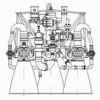 | RD-809 Yuzhnoye LOx/Kerosene rocket engine. Upper stages. 2007 design concept for a four-chamber restartable main engine for launch vehicle upper stages. |
| RDKS-100 Dushkin LOx/Kerosene rocket engine. Sanger. Developed 1946-51. |
| RKDS-100 Glushko LOx/Kerosene rocket engine. Keldysh Bomber. Design 1946. Nominal design engine for 1946 Keldysh bomber design. The Soviet Union would not produce an engine with these propellants and thrust levels until nearly 20 years later. |
| RLA-1 LOx/Kerosene propellant rocket stage. Empty mass, specific impulses, length estimated by comparison to smaller Zenit successor design. |
| RLA-1200 Glushko LOx/Kerosene rocket engine. Design 1974. Proposed engines for the RLA series launch vehicles. This version would use four chambers. 'Down-sized' to 200 metric tons thrust for Energia. |
| RLA-2 LOx/Kerosene propellant rocket stage. Empty mass, specific impulses, length estimated by comparison to smaller Zenit successor design. |
| RLA-300 Glushko LOx/Kerosene rocket engine. Design 1974. Proposed for the RLA series launch vehicles and the UR-700M Mars booster. Following rejection of RLA, design 'down-sized' to 200 metric tons thrust for Energia and Zenit. |
| RLA-600 Glushko LOx/Kerosene rocket engine. Design 1972. Two-chamber version of RLA-300. Proposed for the RLA series launch vehicles and the UR-700M Mars booster. |
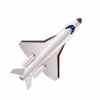 | Rocketplane XP American manned spaceplane. Study 2015. The Rocketplane XP Vehicle was a proposed suborbital manned spaceplane with accommodations for four crew. |
| Rotary Rocket XCOR LOx/Kerosene rocket engine. First stages. Developed in 1990's. Developed and tested by Rotary Rocket for their launcher before its cancellation. |
| RPD-04 Dushkin LOx/Kerosene rocket engine. Out of Production. |
 | RS-27 Rocketdyne LOx/Kerosene rocket engine. Out of production. Consisted of RS2701A/B main engine, and twin LR101-NA-11 verniers. Introduced in 1974 on the McDonnell Douglas' Delta 2000 series launcher; replaced the MB-3. First flight 1972. It completed its Delta service on the 6000 model in 1992, then continued as part of the Atlas MA- 5A powerplant until the retirement of the Atlas. |
 | RS-27A Rocketdyne LOx/Kerosene rocket engine. . Replaced the RS-27 as the main system for the Delta 7000 and in the MA- 5A for the Atlas. RS2701B main engine, and twin LR101-NA-11 verniers. First flight 1989. |
 | RS-27C Rocke. First flight 1990. |
 | RS-34 Attitude Control Rocketdyne LOx/Kerosene rocket engine. Peacekeeper Postboost Attitude Control. Pressure-fed. 8 attitude thrusters in each postboost propulsion system. First flight 1983. |
 | RS-36 Sustainer Rocketdyne LOx/Kerosene rocket engine. HOE Homing Overlay Experiment Upper Stage Axial Propulsion System. Pressure-fed. Derivative of Lance propulsion system. First flight 1983. |
 | RS-56-OBA Rocketdyne LOx/Kerosene rocket engine. Out of production. Designed for booster applications. Gas generator, pump-fed. Booster engine for Atlas II, IIA, IIAS. First flight 1991. |
 | RS-56-OSA Rocketdyne LOx/Kerosene rocket engine. Out of production. Designed for booster applications. Gas generator, pump-fed. Sustainer engine for Atlas II, IIA, IIAS. First flight 1991. |
 | RS-76 Rocketdyne LOx/Kerosene rocket engine. Space Shuttle Reusable First Stage. Ox-Rich staged combustion, pump-fed. Thrust and specific impulse values are at sea level. |
 | RS-84 Rocketdyne LOx/kerosene rocket engine. Booster stages. Development ended 2005. Design for NASA's Space Launch Initiative; borrowed extensively from Russian technology developed in the forty years since the USA abandoned the F-1. |
| RS-X Rocketdyne LOx/Kerosene rocket engine. Design concept -1997. Employed existing Delta and Atlas MA and RS engine hardware with a new thrust chamber assembly to generate a thrust of 1890 kN for ELV applications. |
| RZ.2 Rolls Royce LOx/Kerosene rocket engine. Used on Europa launch vehicle. First flight 1964. |
| S1.35800 Korolev LOx/Kerosene rocket engine. R-7 verniers. Out of Production. Thrust variable 2.5-3.1 metric tons |
 | S1.5400 Korolev LOx/Kerosene rocket engine family. Designed by Korolev; passed to Isayev for production. Began a series of engines leading through the 8D726 for GR-1 to the Block D for the N1 and Proton. |
| S1.5400A Korolev LOx/Kerosene rocket engine. Molniya 8K78M-3. First flight 1964. |
| S2.253 derivative Isayev LOx/Kerosene rocket engine. EKR (experimental winged missile). Study 1953. Derivative of S2.253 was proposed for use in EKR Stage 1 (project for an experimental winged missile). |
 | S-3 Rocketdyne LOx/Kerosene rocket engine. Juno II, Saturn A-2 studies of 1959. First flight 1958. |
 | S-3D Rocketdyne LOx/Kerosene rocket engine. Jupiter Booster. Gas generator, pump-fed. Thrust later 150,000 lbs. Thrust and specific impulse values are at sea level. First flight 1957. |
| S-4 engine Rocketdyne LOx/Kerosene rocket engine. Design ca. 1957. Version of Atlas sustainer tailored to Redstone Arsenal upper-stage requirements. Paper study only. Used on Super Jupiter launch vehicle. |
| S5.80.1100-0 Isayev LOx/Kerosene rocket engine. Soyuz-2 Blok LM. Developed 1990s. Thrust chamber from KTDU-80 / S5.80 converted to burn LOx/Kerosene. |
| Saturn IB stage LOx/Kerosene propellant rocket stage. Configuration as flown, Saturn IB. |
| Saturn IB-11 LOx/Kerosene propellant rocket stage. 20 foot stretch of Saturn IB for use with UA1207 7 segment solid rocket strap-on units. |
| Saturn IB-15 LOx/Kerosene propellant rocket stage. 10 foot stretch of Saturn IB. Not found useful in any configuration except with Minuteman first-stage strap-ons to augment thrust. |
 | Saturn IC LOx/Kerosene propellant rocket stage. Configuration as flown. |
| Saturn IC C-3B LOx/Kerosene propellant rocket stage. Final first stage design of Saturn C-3 (November 1961). |
| Saturn IC C-4B LOx/Kerosene propellant rocket stage. Final first stage design of Saturn C-3 (November 1961). Unique S-IC design in that fuel and propellant tank shared common bulkhead; stage was actually shorter than C-3B S-IC. |
| Saturn IC C-5A LOx/Kerosene propellant rocket stage. Final first stage design of Saturn C-5 (November 1961) before selection as Apollo launch vehicle and development in Saturn V. |
| Saturn IC-Flat Bulkhead LOx/Kerosene propellant rocket stage. Standard S-IC but with reduced length and structural weight through use of 'flat' bulkheads consisting of multiple conical sections. |
| Saturn LCB-Lox/RP-1 stage LOx/Kerosene propellant rocket stage. Boeing Low-Cost Saturn Derivative Study, 1967 (trade study of 260 inch first stages for S-IVB, all delivering 86,000 lb payload to LEO): Low Cost Booster, Single Pressure-fed LOx/RFP-1 engine. |
| Saturn MLV 5-23L-0 LOx/Kerosene propellant rocket stage. Liquid strap-on booster studied for improved Saturn V. |
| Saturn MS-IC/260 LOx/Kerosene propellant rocket stage. Standard length S-IC but with feed of propellant from fuel and propellant tanks housed above strap-on solid rocket motors. |
| Saturn MS-IC-1 LOx/Kerosene propellant rocket stage. Basic Saturn IC stretched 240 inches with F-1A engines uprated 20% in thrust and 6 second improvement in specific impulse. |
| Saturn MS-IC-1A LOx/Kerosene propellant rocket stage. Basic Saturn IC stretched 240 inches with 6 F-1 engines. |
| Saturn MS-IC-23(L) LOx/Kerosene propellant rocket stage. Basic Saturn IC stretched 240 inches with standard F-1 engines. |
| Saturn MS-IC-25(S) LOx/Kerosene propellant rocket stage. S-IC with 41.5 foot stretch, 6,640,0000 lbs propellant, uprated F-1 engines. |
| Saturn MS-IC-3B LOx/Kerosene propellant rocket stage. S-IC with 20 foot stretch, 1.8 million lb thrust F-1's, 5.6 million pounds propellant capacity (fuel offloaded to 4.99 million for LEO or 4.80 million lbs for LOR mission). |
| Saturn MS-IC-4(S)B LOx/Kerosene propellant rocket stage. S-IC with 336 inch stretch, 6,000,0000 lbs propellant, structural strength increased from 56% to 65% depending on station, resulting in 13.9% increase in empty weight. |
| Saturn MS-LRB-23(L) LOx/Kerosene propellant rocket stage. Liquid rocket booster strap-ons using 2 F-1's. |
| Saturn S-1B-4 LOx/Kerosene propellant rocket stage. Chrysler Studies, 1966: S-1B with 4 H-1's for use with Titan UA1205 strap-ons. |
| Saturn S-IB-A LOx/Kerosene propellant rocket stage. Douglas Studies, 1965: S-1B with 225 k lbf H-1's. |
| Saturn S-IC-TLB stage LOx/Kerosene propellant rocket stage. Boeing Low-Cost Saturn Derivative Study, 1967 (trade study of 260 inch first stages for S-IVB, all delivering 86,000 lb payload to LEO): S-IC Technology Liquid Booster: 260 inch liquid booster with 2 x F-1 engines, recoverable/reusable. |
| Saturn S-ID Booster LOx/Kerosene propellant rocket stage. Boeing studies, 1967:'Stage and a half' S-1C with four outboard F-1's jettisoned and inboard F-1 functioning as sustainer as in Atlas. Booster half stage recoverable. Mass estimated based on double mass of four F-1's (based on Atlas example). |
| Saturn S-ID Sustainer LOx/Kerosene propellant rocket stage. Boeing studies, 1967:'Stage and a half' S-1C with four outboard F-1's jettisoned and inboard F-1 functioning as sustainer as in Atlas. Booster half stage burns 124 seconds in this configuration. |
| Saturn S-ID Sustainer-1 LOx/Kerosene propellant rocket stage. Boeing studies, 1967:'Stage and a half' S-1C with four outboard F-1's jettisoned and inboard F-1 functioning as sustainer as in Atlas; 20 foot stretch of sustainer stage. Booster stage burn 154 seconds in this configuration. |
| Sea Dragon-1 LOx/Kerosene propellant rocket stage. Truax pressure fed design. Sea level thrust shown. Thrust, chamber pressure varies during ascent. Vacuum thrust at cut-off 40 million kgf. Total mass, specific impulse estimated from booster performance figures. |
| Sea Dragon-1 engine Aerojet LOx/Kerosene rocket engine. Design, 1962. Truax pressure fed design. Thrust, chamber pressure varied during ascent. |
| S-I stage LOx/Kerosene propellant rocket stage. Configuration as flown, Saturn I. |
| Soyuz 11A511U-0 LOx/Kerosene propellant rocket stage. Gross mass includes 1190 kg of hydrogen peroxide and 280 kg of liquid nitrogen expended during ascent but not contributing to propulsion. |
| Soyuz 11A511U-1 LOx/Kerosene propellant rocket stage. Current version. Gross mass includes 2600 kg of hydrogen peroxide and 520 kg of liquid nitrogen expended during ascent but not contributing to propulsion. |
| Soyuz M-0 LOx/Kerosene propellant rocket stage. . |
| Soyuz M-1 LOx/Kerosene propellant rocket stage. Proposed improved version. Not developed. |
| Soyuz M-3 LOx/Kerosene propellant rocket stage. Empty mass estimated. Multiple restart engine. |
| Soyuz ST-0 LOx/Kerosene propellant rocket stage. Gross mass includes 1190 kg of hydrogen peroxide and 280 kg of liquid nitrogen expended during ascent but not contributing to propulsion. |
| Soyuz ST-1 LOx/Kerosene propellant rocket stage. Gross mass includes 2600 kg of hydrogen peroxide and 520 kg of liquid nitrogen expended during ascent but not contributing to propulsion. |
| Soyuz ST-2 LOx/Kerosene propellant rocket stage. . |
 | Starchaser 5 British manned spacecraft. Study 2004. X-Prize suborbital ballistic spacecraft concept of Starchaser Industries, Cheshire, England. The concept used a rocket powered vertical takeoff followed by a parachute descent to land. |
 | Super-Jupiter stage LOx/Kerosene propellant rocket stage. Earliest member of what would become the Saturn family. Masses estimated. |
| Superraket Block A LOx/Kerosene propellant rocket stage. Ancestor of N1 Block A; conical liquid oxygen/kerosene stage using massive cluster of Kuznetsov engines. Gross mass estimated based on 2,000 metric ton total vehicle weight; empty mass estimated. |
| Thor DM-19 LOx/Kerosene propellant rocket stage. . |
| Thor DM-21 LOx/Kerosene propellant rocket stage. . |
| Titan 1-1 LOx/Kerosene propellant rocket stage. . |
| Titan 1-2 LOx/Kerosene propellant rocket stage. . |
| Titan Cluster LOx/Kerosene propellant rocket stage. Masses estimated (cluster of four Titan I first stages). |
 | TMK-1 Russian manned Mars flyby. Study 1959. In 1959 a group of enthusiasts in OKB-1 Section 3 under the management of G U Maksimov started engineering design of this first fantastic project for manned interplanetary travel. |
| TR-107 TRW LOx/kerosene rocket engine. Booster stages. TRW design for NASA's Space Launch Initiative. The engine used duct-cooling of the main combustion chamber and materials that would not interact with kerosene to minimize coking. |
| UR-500MK-1 LOx/Kerosene propellant rocket stage. Empty mass estimated based on overall vehicle mass fraction. Length estimated based on total mass. |
| UR-500MK-2 LOx/Kerosene propellant rocket stage. Empty mass estimated based on overall vehicle mass fraction. Length estimated based on total mass. |
| UR-700M-1 LOx/Kerosene propellant rocket stage. Total mass, length, estimated based on empty mass, total vehicle mass. Engine specific impulse estimated based on follow-on RD-170 engines. |
| UR-700M-2 LOx/Kerosene propellant rocket stage. Total mass, length, estimated based on empty mass, total vehicle mass. Engine specific impulse estimated based on follow-on RD-170 engines. |
| Vanguard-1 LOx/Kerosene propellant rocket stage. . |
| VKS-R Sled LOx/Kerosene propellant rocket stage. Sled studied in tradeoff studies leading to MAKS. Release conditions: Piggy-back, 290,000 kg, Mach 0.5, zero altitude. Effective velocity gain compared to vertical launch 100 m/s. |
| Vulkan 0 LOx/Kerosene propellant rocket stage. Original design of Energia strap-ons, for use with Vulkan booster for manned lunar expedition. Ultimately derived from R-56 of 1961. |
 | X-1 Rocketdyne LOx/Kerosene rocket engine. Booster applications. Gas generator, pump-fed. Thrust from 165,000 to 198,000 lbs. |
 | X-34 NASA failed to attract industry co-investment to develop the original X-34A air-launched, reusable, low-technology, low-cost orbital launch vehicle concept. So the project was scaled back and NASA contracted with Orbital Sciences on 28 August 1996 to build and fly the X-34 unmanned technology demonstrator. This program in turn developed overruns and was cancelled in 2001 before a test flight was made. |
| X-34A-1 LOx/Kerosene propellant rocket stage. Original design for the winged first stage of the X-34A. |
| X-34A-2 LOx/Kerosene propellant rocket stage. Original design for the second stage of the X-34A. |
| X-405 GE LOx/Kerosene rocket engine. Vanguard 1st stage. First flight 1957. |
 | XLR105-5 Rocketdyne LOx/Kerosene rocket engine. Atlas D. Atlas Sustainer. Gas generator, pump-fed. Shared turbopumps for booster engines. First flight 1958. |
 | XLR83-NA-1 Rocketdyne LOx/Kerosene rocket engine. Out of production. Experimental version of the engine for the booster of the Navaho G-38 intercontinental cruise missile. Flown in the Navaho G-26 booster prototypes. First flight 1956. |
 | XLR89-1 Rocketdyne LOx/Kerosene rocket engine. Atlas A, B, C. Out of production. Designed for booster applications. Gas generator, pump-fed. Shared turbopumps for booster engines. First flight 1957. |
 | XLR89-5 Rocketdyne LOx/Kerosene rocket engine. Atlas D. Designed for booster applications. Gas generator, pump-fed. Shared turbopumps for booster engines. First flight 1958. |
| XR4K14 XCOR LOx/Kerosene rocket engine. First stages. Hardware. Built for the Rocket Racing League's first X-Racer. The rocket engine was sized for the best compromise between acceleration and endurance. |
| XR4K5 XCOR LOx/Kerosene rocket engine. First stages. Hardware. Pump-fed, regeneratively cooled with fuel. Engine could be used to power the prototype Xerus suborbital manned vehicle for initial flight testing. |
| YaKhR-2 Strap-on LOx/Kerosene propellant rocket stage. R-7 strap-ons increased in size dimensionally 50%, equipped with 6 engines from R-9. Boost nuclear thermal core stage to altitude before ignition of nuclear engine. Masses calculated based on vehicle total weight and performance. |
| YF-100 CAALPT LOx/Kerosene rocket engine, for CZ-7 Next Generation Launch Vehicle series. Engine can be throttled to 65% of rated thrust. Firing tests began in 2005. First flight 2016. |
| YF-115 CAALPT LOx/Kerosene rocket engine, for CZ-7 Next Generation Launch Vehicle's second stage. Staged combustion cycle. First flight 2016. |
 | Zenit-A LOx/Kerosene propellant rocket stage. Modification of same stage used as strap-on for Energia launch vehicle. |
| Zenit-B Zenit stage 2. LOx/Kerosene propellant rocket stage. |
| Zenit-V Zenit stage 3. LOx/Kerosene propellant rocket stage. Adaptation of Block D for Zenit. |
Engines:
RDKS-100,
D-2 engine,
RD-106,
S2.253 derivative,
B-2C,
RD-0102,
S1.35800,
XLR83-NA-1,
LR79-7,
S-3D,
XLR89-1,
LR87-3,
LR91-3,
MB-3-1,
RD-0103,
RD-0105,
S-4 engine,
X-1,
LR83-NA-1,
H-1 engine,
LR105-5,
LR89-5,
RD-0107,
XLR105-5,
XLR89-5,
S-3,
NK-9V,
RD-0109,
RD-111,
LR105-7,
LR89-7,
MB-3-J,
NK-19,
RD-0108,
S1.5400A,
MB-3 Press Mod,
Sea Dragon-1 engine,
NK-15V,
NK-21,
RD-108-8D727K,
5 mlbf RP-4,
P4-1 Booster,
P4-1 Sustainer,
RD-0110,
H-1c,
11D51F,
11D51M,
11D52F,
11D52M,
11D53F,
11D53M,
F-1A,
NK-31,
NK-39,
NK-43,
NK-33,
RD-58M,
RS-27,
NK-15F,
17D11,
17D12,
RD-171,
RS-34 Attitude Control,
RS-36 Sustainer,
RD-58S,
RS-27A,
RS-56-OBA,
RS-56-OSA,
RD-0124-14D23,
RD-0210-HC,
RD-0244-HC,
RD-0245-HC,
RD-58Z,
S5.80.1100-0,
RD-0124,
RD-134R,
RD-146,
RD-180,
RD-120K,
RD-172,
RD-161-2,
RD-173,
RD-120M,
RD-174,
RD-0234-HC,
RD-0256-HC,
RD-191,
RD-191M,
RD-0124M,
RD-0124M1,
RD-0242-HC,
RD-107-11D511,
RD-108-11D512,
RD-161-1,
Merlin 1A,
Merlin 1C,
Merlin 1Cvac,
RD-802,
RD-809,
8D726,
8D415K,
AABS,
E-1,
F-1,
Fastrac,
FastTrack,
H-1b,
Kestrel,
KS-50,
LR101-11,
LR105-3,
L-1 Linear Aerospike Booster,
L-2 Linear Aerospike Booster,
L-6.55,
L-7.70,
Liberty engine,
Liberty-1,
MB-3-3,
MA-5A,
Microcosm 22N,
Microcosm 356N,
Microcosm 89N,
NK-9V-11D53,
NK-9V-11D54,
NK-15,
NK-9,
PF RP-1,
Press Fed 25k,
RD-120.01,
RD-120.03,
RD-107-8D74,
RPD-04,
RD-108-8D75,
RD-107-8D76,
RD-108-8D727,
RD-108-8D77,
RD-117,
RD-107-8D728,
RD-107-8D74-1958,
RD-108-8D75-1958,
RD-118,
RD-107-8D74-1959,
RD-108-8D75-1959,
RS-27C,
RD-117PF,
RD-58MF,
RD-107-8D74K,
RD-108-8D75K,
RD-107-11D511P,
RD-108-11D512P,
RD-107-8D74PS,
RD-108-8D75PS,
RD-0106,
RD-0154,
RD-0155,
RD-105,
RD-110,
RD-120,
RD-134,
RD-170,
RD-58,
RD-8,
RKDS-100,
RLA-1200,
RLA-300,
RLA-600,
Rotary Rocket,
RS-76,
RS-84,
RS-X,
RZ.2,
TR-107,
X-405,
XR4K14,
XR4K5,
YF-120t.
Spacecraft:
MPK,
Ames Mach 10 Demonstrator,
TMK-1,
Mavr,
Starchaser 5,
Michelle-B,
Pioneer XP,
CEV Spacehab,
CEV Spacehab SM,
Rocketplane XP.
Launch Vehicles:
R-3.
Stages:
Saturn IC,
Falcon 1-1,
Falcon 1-2,
Falcon 1e-1,
X-34A-2,
KSR-3,
Liberty 1,
X-34,
Sea Horse-1,
CZ-NGLV-KO,
N1 Block G,
Europa-1,
Super-Jupiter-2,
Sanger-Bredt,
VKS-R Sled,
Kistler Stage 2,
Angara UM,
CZ-NGLV-300,
RLA-2,
N1 Block V,
Kistler Stage 1,
Project 921-1,
Atlas CCB,
Vulkan 0,
Angara Stage 1,
N1 Block B,
RLA-1,
Jarvis-1,
N1 Block A,
UR-700M-2,
UR-700M-1,
Sea Dragon-1,
Keldysh Bomber stage,
Keldysh Sled,
YaKhR-2 Strap-on,
EKR Stage 1,
Sputnik 8K71PS-1,
Super-Jupiter stage,
Navaho G-38 Booster,
Super-Jupiter-3,
Titan 1-2,
Jupiter Cluster,
Nova 59-4-1,
Nova 59-4-2,
Nova NASA-1,
Nova NASA-2,
Superraket Block A,
Titan 1-1,
Titan Cluster,
Vanguard-1,
Atlas Able stage,
Luna 8K72-0,
Luna 8K72-1,
Luna 8K72-2,
Nova 2 F-1 Module,
Nova 60-8-1,
Nova 9L-1,
Nova 9L-2,
Nova A-1,
Nova B-1,
Saturn S-IB-2,
Saturn S-IB-4,
Saturn S-IC-8,
S-I stage,
Vostok 8K72-0,
Vostok 8K72-1,
Vostok 8K72-2,
Atlas Centaur LV-3C stage,
R-7 8K71-0,
R-7 8K71-1,
Saturn IC C-3B,
Saturn IC C-4B,
Saturn IC C-5A,
N1 1962 - B,
N1 1962 - V,
N-111-A,
N-11GR - V,
Jupiter (stage),
N1 1962 - A,
N-11 1963 - V,
N-11 Block A,
N-11 Block B,
Nova DAC-1,
Nova GD-B-1,
Nova GD-F-1,
Nova GD-J-1,
Nova MM 1B-1,
Nova MM 1C-1,
N1 1964 - A,
N1 1964 - B,
N1 1964 - V,
Vostok 8K72K-0,
Vostok 8K72K-1,
Vostok 8K72K-2,
Molniya 8K78-0,
Molniya 8K78-1,
Molniya 8K78-2,
Molniya 8K78-3,
N1F 1965 - A,
N1F 1965 - B,
N1F 1965 - V,
N1M 1965 - A,
N1M 1965 - B,
N1M 1965 - V,
N1U 1965 - A,
N1U 1965 - B,
N1U 1965 - V,
Saturn IB stage,
Saturn IC-Flat Bulkhead,
Saturn MS-IC-1A,
Saturn S-IB-A,
Saturn IB-11,
Saturn IB-15,
Saturn MLV 5-23L-0,
Saturn MS-IC-4(S)B,
Saturn S-1B-4,
R-7A 8K74-0,
R-7A 8K74-1,
Saturn LCB-Lox/RP-1 stage,
Saturn MS-IC/260,
Saturn MS-IC-1,
Saturn MS-IC-23(L),
Saturn MS-IC-3B,
Saturn MS-LRB-23(L),
Saturn S-IC-TLB stage,
Saturn S-ID Sustainer-1,
Vostok 8A92-0,
Vostok 8A92-1,
Vostok 8A92-2,
Delta Thor TA,
Saturn MS-IC-25(S),
Saturn S-ID Booster,
Saturn S-ID Sustainer,
R-9A Stage 1,
R-9A Stage 2,
Thor DM-21,
N1 Block D,
Delta Thor LT,
N1F Block A,
N1F Block B,
N1F Block V,
Energia Strapon,
Block D,
Proton 11S824,
Soyuz 11A511-0,
Soyuz 11A511-1,
Soyuz 11A511-2,
Voskhod 11A57-0,
Voskhod 11A57-1,
Voskhod 11A57-2,
Thor DM-19,
Kvant-1 stage,
Delta Thor XLT-C,
Delta Thor RS27,
Proton 11S824M,
Delta Thor ELT,
Proton 11S86,
Vostok 8A92M-0,
Vostok 8A92M-1,
Vostok 8A92M-2,
Delta Thor XLT,
H-1-1,
Black Colt AV,
Kvant-1-1,
Atlas E/F,
Atlas MA-3,
Proton 11S824F,
Soyuz 11A511U2-0,
Soyuz 11A511U2-1,
X-34A-1,
Zenit-A,
Zenit-B,
Zenit-V,
UR-500MK-1,
UR-500MK-2,
Delta 3 - 1,
Soyuz 11A511U-0,
Soyuz 11A511U-1,
Soyuz M-0,
Soyuz M-1,
Soyuz M-3,
Atlas IIIA,
Soyuz 11A511U2-2,
8K513 Blok B,
Angara A-2,
Atlas MA-2,
Atlas Agena SLV-3,
Atlas MA-5,
Atlas A stage,
Atlas Agena LV-3A,
Atlas Agena SLV-3A,
Atlas IIA stage,
Atlas MA-5A,
Atlas B stage,
Atlas Centaur SLV-3C/D,
Atlas D stage,
Atlas G/H/I,
Atlas II stage,
Atlas IIAS stage,
Atlas MA-5AS,
Blok SO-L,
CZ-NGLV-200 stage,
GR-1 Stage 1,
GR-1 Stage 3,
Molniya 8K78M-0,
Molniya 8K78M-1,
Molniya 8K78M-2,
Molniya 8K78M-3,
Molniya M-3,
N-111-Ab,
Proton 17S40,
Proton 11S861,
Proton 11S861-01,
Soyuz ST-0,
Soyuz ST-1,
Sputnik 8A91-1,
Soyuz 11A511U-2,
Soyuz ST-2.
Back to top of page
Home - Search - Browse - Alphabetic Index: 0- 1- 2- 3- 4- 5- 6- 7- 8- 9
A- B- C- D- E- F- G- H- I- J- K- L- M- N- O- P- Q- R- S- T- U- V- W- X- Y- Z
© 1997-2019 Mark Wade - Contact
© / Conditions for Use

